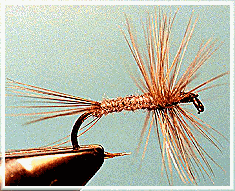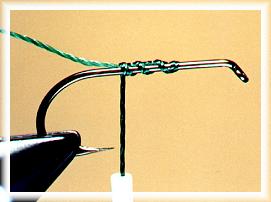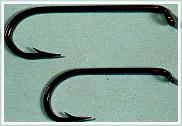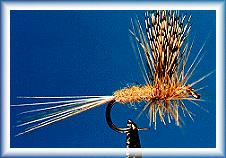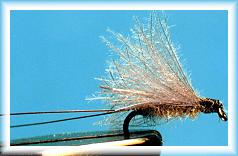The Adams
The Adams is probably the most popular dry fly of all time. It might be the simple name that draws people to this fly, but I would bet it is results that keep them coming back. This is one very productive fly. It matches most mayfly hatches well enough to work most of the time, and it can be tied in any variety of sizes to fit most needs.
You already have the skills to tie a regular Adams, except you haven’t wrapped two hackles on the same fly yet, and that’s how the Adams is tied. It isn’t hard to wrap two hackles on one fly (or four for that matter), you just have to try it to know you can do it. We will also tie our first hair tail and learn another method of tying hackle tip wings to a hook. See, we’re learning something new every week.
I mentioned several weeks ago that the hackle floats the fly by resting on the surface tension of the water. If you increase the amount of hackle on a fly, you can fish it in faster water because of the increased buoyancy created by the extra hackle in contact with the surface tension of the water.
Many “western” flies have more hackle on them than their eastern counterparts because western waters tend to be faster on average than eastern waters. Many of the flies I tie have a decidedly western “flavor” in that they are heavier hackled than those used in calmer waters.
As we progress from the Adams to the Royal Wulff (later) and the Humpy (even farther away) you will notice the heavier hackle on these western style flies. If you live in an area that has calm water, you might find these heavier hackled flies a bit “thick” for your water. Don’t give up yet, most patterns can be adapted to any type of water by tying them with more or less hackle.
If you feel you need to adapt this or any fly to a calmer type of water, just extend the body slightly, and wrap less hackle on a shorter portion of the hook shank. That means less hackle wraps, and a fly that floats in slow water but would sink in fast water. That wasn’t too hard was it?
Of course, some flies were designed for fast water, and adapting them to slow water would be a disaster. Wulff, Humpy and Stimulator patterns must have heavy hackle to look or perform right, and therefore are specialty flies designed for fast water. Likewise, some flies were designed for slow water, (Catskill dry flies for example) and adding hackle to them to increase the floatation qualities of the fly would be grounds for expulsion from the ranks of purist Catskill fly fishing clubs.
The Adams is one fly that can be adapted to almost any type of water. It can also be tied as a thorax fly with various types of wing material, and several types of tails. If you’re like me, you won’t be content to merely tie the traditional dressing, but would rather experiment a little with the skills you have learned to this point. You might also want to tie this fly in some heavy hackled versions for riffles and pocket water, and some lightly hackled versions for calmer water.
Experiment with different types and colors of body materials and wing materials. It won’t be an Adams anymore, but it will probably catch fish. That’s the beauty of tying your own flies, you can create, modify, alter, adjust and refine any pattern you wish, and still use the same basic tying steps you would use on another fly.
Let’s get to this week’s pattern. If you don’t have the right hackle for this pattern, use the hackle you have with the same tying steps as a form of practice. For instance, if you use dun hackle and wings, you simply create a Gray Dun instead of an Adams.
List of materials: The Adams
Hook: Standard dry fly; Mustad 94840, Tiemco 100, Eagle Claw L059, Daiichi 1180. Size 10 - 22.
Thread: 6/0 to 10/0 Gudebrod or equivalent, color to match body or black.
Body: Angler’s Choice pure silk dubbing, muskrat under-fur, or any other synthetic or natural fine dubbing.
Wing: Grizzly hackle tips from spade hackles or the hackle found at the top of the neck. Hen hackle tips also work well. Length of the wing should be about 1 1/2 times the hook gap.
Hackle: Quality neck or saddle hackle, webby parts removed and 1/16” of the remaining stem stripped of barbules. One grizzly and one brown hackle. (Be careful to match the length of the barbules of the hackle feathers.)


